Adopting complexity science in policymaking: The soft underbelly
As cities becoming increasingly complex, how can policymakers manage this complexity to ensure that cities remain sustainable, resilient and liveable? Dr. Darren Nel and Professor Araz Taeihagh examine the difficulties for policymakers in incorporating tools from complexity science to address these challenges.

Dr Darren Nel,
Postdoctoral Fellow,
Lee Kuan Yew School of Public Policy

Professor Araz Taeihagh,
Assistant Professor of Public Policy,
Lee Kuan Yew School of Public Policy
Introduction: Grasping complexity
In an era marked by increasing interconnectedness and technological advancement, the systems that underpin societies — from transportation and energy grids to healthcare and financial markets — are becoming increasingly complex. This complexity poses significant challenges for policymakers, as traditional, linear approaches to governance often fall short in addressing the dynamic and unpredictable nature of these systems.
In response to these challenges, for nearly 80 years, policymakers have been encouraged to adopt complexity-informed approaches to policymaking, so as to offer a better framework for understanding and managing complex systems [1]. However, despite its potential, the integration of complexity science into mainstream policymaking has been slow and limited [2]. Our research [3] explores the reasons behind this gap between the promise and practice of complexity science. Our study focused on the non-technical challenges that have hindered the widespread adoption of complexity science in policymaking.
Note: This article is based on a paper by the authors: The Soft Underbelly of Complexity Science Adoption in Policymaking (Nel & Taeihagh, 2024). This open access paper can be found at the Policy Sciences website:
https://doi.org/10.1007/s11077-024-09531-y.

The promise of complexity science for policymaking
Complexity science - an interdisciplinary field encompassing a collection of approaches, including systems thinking, systems theory, complexity theory, and network science - challenges the traditional reductionist approaches. Instead of breaking systems into constituent parts, complexity science emphasises a holistic perspective, focusing on interactions and relationships within the systems. This approach reveals emergent properties — behaviours or patterns arising from these interactions that cannot be predicted from the individual parts alone.
Some key concepts in complexity science include:
- Feedback loops, where a system's output re-enters as input, amplifying or dampening effects;
- Non-linearity, where small changes can lead to disproportionately large effects, which makes predicting outcomes based on initial conditions challenging; and
- Self-organisation and emergence, which illustrate how complex systems spontaneously develop new structures and behaviours from the interactions of their components.
Adopting complexity science in policymaking offers significant benefits. Policymakers can better manage complex adaptive systems such as ecosystems, economies, and cities by understanding these key concepts. This understanding aids in identifying patterns and predicting behaviours, facilitating the development of effective strategies for managing these systems. For example, complexity-based models in traffic management optimise flow and reduce congestion, while in epidemiology, they predict disease spread and evaluate interventions. Moreover, recognising the interdependence of system components enables policymakers to design more resilient and adaptive policies.
By considering feedback loops, they can anticipate the long-term impacts of policies, and avoid unintended consequences. The non-linearity principle helps in acknowledging that small policy adjustments can yield significant outcomes, promoting innovative and scalable solutions, while also recognising the inherent uncertainty in complex systems. In essence, integrating complexity science into policymaking fosters a more nuanced and responsive approach to governance. It shifts the focus from isolated problem-solving to a comprehensive understanding of systemic interactions, ultimately leading to more sustainable and effective policies. This interdisciplinary approach equips policymakers with the tools to navigate the intricate realities of modern societal challenges, ensuring more robust and adaptive governance structures.
Despite its potential benefits, there are no ‘complexity units’ within governments, like one might find for social media [4]. Thus, the question remains: why has complexity science struggled to be adopted into mainstream policy debate, as well as the everyday decision-making of policymakers?

Methodology of this study
To answer the question of why complexity science remains underutilised in policymaking, we conducted an extensive literature review, using a scoping review approach. A scoping review is a systematic process that allows for the screening, identification, and assessment of the existing knowledge base of a topic [5]. Our review focused on peer-reviewed articles that discussed the use of complexity science in policymaking and specifically mentioned challenges or barriers to its adoption.
The search strategy involved querying the SCOPUS database using a comprehensive search string that included terms related to complexity science, policymaking, and challenges. The initial search yielded 9,943 studies, which were initially screened based on their titles and abstracts. At the full-text level, we screened 1,086 full-text papers. This screening process resulted in the selection of 336 articles for in-depth analysis.
The analysis of these articles revealed 141 unique challenges to the adoption of complexity science in policymaking. These challenges can be placed into three broad categories, Technical (46.2%), Conceptual and Methodological (18.6%), and Non-technical (35.2%). Figure 1 shows a summary of the main challenges identified in the literature.

The focus of this study was on the non-technical challenges, where we define as challenges factors involving human and organisational issues. Furthermore, they are not directly related to the technical aspects of complexity science (i.e. modelling, data, hardware, or software) or theoretical and methodological considerations, as these aspects tend to be more academic or abstract, and are often aspects that policymakers are less concerned about.
We grouped the non-technical challenges into three overarching themes:
- management, cost, and adoption challenges;
- limited trust, communication, and acceptance;
- and ethical barriers.
Barriers to adoption complexity science in policymaking. The literature suggests that that these are the dominant non-technical barriers to the use of complexity science in, and for, policymaking within each of the identified themes.
Management, cost, and adoption challenges
Policymakers often have limited interest and understanding of complexity science, finding its abstract nature impractical for immediate policy applications. Complexity science requires a paradigm shift in thinking at a personal and institutional level, which can be difficult without substantial will, capacity-building, and resource allocation.
Furthermore, bureaucratic structures typically favour efficiency, standardisation, and linear approaches, conflicting with the principles of complexity science, making its incorporation into existing workflows challenging.
Additionally, the financial and resource costs associated with developing and implementing complexity-informed models are another hurdle. These costs – which include data collection, model development, and training – can be prohibitive, often exceeding the capacities of many institutions. Additionally, the time required to develop these models and train users is substantial, and can conflict with policy and political timelines, further limiting adoption.
Limited trust, communication, and acceptance
Building trust in complexity-informed approaches is crucial, but challenging. The limited number of successful real-world applications contributes to scepticism among policymakers, who are more likely to trust established methods with proven track records that can demonstrate tangible benefits.
Compounding these issues, is the challenge of effectively communicating complexity science concepts and results. Here, the conceptual ambiguity and inconsistent terminology, along with the technical nature of complexity science, make it difficult for non-experts to grasp its value. The results of complexity-informed models can often be counter-intuitive and information dense, complicating communication efforts.
Thus, policymakers need to be involved in the model-building process to understand and trust the outputs. This also requires developing clear guidelines and standards for reporting complexity-informed models, which also enhances transparency and trust.
However, overcoming entrenched beliefs and paradigms towards systemic thinking is challenging, and necessitates significant educational and capacity-building efforts.
Ethical barriers
Ethical considerations are crucial when using any science, but specifically with complexity science in policymaking. Issues such as data privacy and model transparency must be addressed to ensure ethical use. Policymakers must be transparent about the data and assumptions underlying their models, as these can lead to skewed results and unfair policy outcomes. Ensuring transparency, mitigating biases, and considering real-world implications maintains the ethics of the policymaking process, while also helping to build trust and acceptance among stakeholders.
Strategies for overcoming barriers
Given the broad nature of the identified barriers, what can be done to mitigate or navigate them? Addressing the non-technical challenges to adopting complexity science in policymaking requires a multifaceted approach.
Some potential strategies include the following:
- Disseminate successful case studies to demonstrate the utility and tangible benefits of complexity-informed approaches.
- Building capacity and understanding by investing in training and capacity-building tailored to policymakers. Educational programmes and workshops can bridge the knowledge gap, enabling effective use of complexity- informed approaches. Furthermore, incorporating complexity science into university curricula and professional courses also creates a long-term pipeline of professionals equipped with a complexity perspective.
- Involving policymakers in the modelling process from the beginning to build trust and ensure relevance. Collaborative efforts between modellers and policymakers make complexity-informed efforts more practical and tangible. However, this requires establishing interdisciplinary teams to include diverse perspectives.
- Improving communication and transparency by developing clear guidelines and standards for reporting complexity-informed models. Simplify communication of complexity science concepts through effective visualisations and plain language explanations.
- Addressing ethical concerns by ensuring transparency in model development, and addressing potential biases in data and assumptions for ethical decision-making. Implementing ethical guidelines and frameworks for using complexity science in policymaking can assist policymakers to evaluate the ethical implications of their decisions, considering broader societal impacts, and minimising negative outcomes.
- Encourage the development of adaptive and flexible policies that evolve in response to new information and changing conditions. Complexity science supports experimentation and iterative policy development, which is crucial for addressing dynamic challenges such as climate change and public health crises.
Implications for policy and governance
Adopting complexity science can transform policy and governance practices by encouraging holistic and adaptive strategies over traditional, linear approaches that often result in unintended consequences. Understanding the interconnectedness and non-linearity of complex systems allows policymakers to design policies better suited to real-world challenges. This deeper understanding helps identify leverage points where small interventions can significantly impact the entire system. For instance, in public health, complexity science can pinpoint key factors contributing to the spread of infectious diseases, enabling more targeted and effective interventions.
In evaluating policies, complexity science offers a framework that surpasses linear cause-and-effect relationships by identifying feedback loops, unintended consequences, and emergent properties that traditional methods might miss. This comprehensive approach ensures that the full impact of policies in complex systems are understood and addressed. Additionally, complexity science promotes a more collaborative and participatory approach to decision-making. Recognising that no single actor can control a complex system, it encourages engagement with a wider range of stakeholders, including scientists, experts, and community members. This more inclusive approach leads to more holistic and effective policies aligned with community needs and values.

For Singapore, embracing complexity science in policymaking can significantly enhance its ability to manage urban planning, environmental sustainability, and public health. The city-state’s governance structure and highly interconnected urban environment is ideal for applying complexity-informed approaches. By integrating complexity science, Singapore can develop more adaptive policies that respond to dynamic changes and unforeseen events, ensuring sustainable growth and resilience in the face of global uncertainties.
The strategies outlined here represent initial steps toward overcoming non-technical barriers while harnessing the benefits of complexity science in policymaking. However, adopting complexity science requires a willingness to experiment, and to explore new methods, while appreciating the unpredictable nature of complex systems. By doing so, policymakers can create robust, adaptive, and sustainable policies better suited to contemporary challenges.
References
[1] Cairney P, Geyer R (2015) Introduction. In: Geyer R, Cairney P (eds) Handbook on complexity and public policy. Edward Elgar Publishing, pp 1–15
[2] Eppel E (2017) Complexity thinking in public administration’s theories-in-use. Public Management Review 19:845–861. https://doi.org/10.1080/14719037.2016.1235721
[3] Nel D, Taeihagh A (2024) The soft underbelly of complexity science adoption in policymaking: towards addressing frequently overlooked non-technical challenges. Policy Sci. https://doi.org/10.1007/s11077-024-09531-y
[4] Harrison NE, Geyer R (2021) Challenges to Complexity, Pragmatism and the Case of Brexit. In: Governing Complexity in the 21st Century. Routledge
[5] Grant MJ, Booth A (2009) A typology of reviews: an analysis of 14 review types and associated methodologies. Health Information & Libraries Journal 26:91–108. https://doi.org/10.1111/j.1471-1842.2009.00848.x

